Wine is an open-source, free and easy-to-use program that enables Linux users to run some Windows-based applications on Unix-like operating systems. Wine is a compatibility layer for installing almost all versions of Windows programs.
This article describes a few easy steps to install the latest stable version of Wine 5.0.2 under Debian 10/9, Ubuntu 20.04-16.04, and Linux Mint 20-19 systems, and also we will see how to configure wine, install windows software and Un-install.
You can find out all the new features and changelog of this new release at the Wine announcement project page.
On this page
Installation of Wine 5.0 on Ubuntu, Linux Mint and Debian
If you looking to have a most recent version of Wine 5.0 stable series, you have to use a new Wine repository PPA which offers both development versions and stable versions of Wine for Debian, Ubuntu, and Linux Mint.
Install Wine on Ubuntu and Linux Mint
To install Wine 5.0 on Ubuntu and Linux Mint, open the terminal by hitting 'CTRL + ALT + T‘ from the desktop and run the following commands to install it:
----------------- On Ubuntu & Linux Mint ----------------- $ sudo dpkg --add-architecture i386 [Enable 32-bit Arch] $ wget -nc https://dl.winehq.org/wine-builds/winehq.key $ sudo apt-key add winehq.key $ sudo add-apt-repository 'deb https://dl.winehq.org/wine-builds/ubuntu/ focal main' [Ubuntu 20.04 & Linux Mint 20] $ sudo add-apt-repository 'deb https://dl.winehq.org/wine-builds/ubuntu/ bionic main' [Ubuntu 18.04 & Linux Mint 19.x] $ sudo apt-add-repository 'deb https://dl.winehq.org/wine-builds/ubuntu/ xenial main' [Ubuntu 16.04 & Linux Mint 18.x] $ sudo apt-get update $ sudo apt-get install --install-recommends winehq-stable
If you get the error “winehq-stable : Depends: wine-stable (= 5.0.0~bionic)“, while installing wine, you need to add the following PPA to fix the error.
$ sudo add-apt-repository ppa:cybermax-dexter/sdl2-backport $ sudo apt-get update $ sudo apt-get install --install-recommends winehq-stable
Install Wine on Debian
To install Wine on Debian.
$ sudo dpkg --add-architecture i386 $ wget -nc https://dl.winehq.org/wine-builds/winehq.key $ sudo apt-key add winehq.key
Next add the following repository to /etc/apt/sources.list or create a *.list under /etc/apt/sources.list.d/ with the following content.
deb https://dl.winehq.org/wine-builds/debian/ buster main [Debian 10 (Buster)] deb https://dl.winehq.org/wine-builds/debian/ stretch main Debian 9 (Stretch)
Note: Don’t forget to replace DISTRO with your Debian release either buster or stretch.
Now update the package repository database and install Wine as shown.
$ sudo apt-get update $ sudo apt-get install --install-recommends winehq-stable
Installing Wine Using Source Code on Debian, Ubuntu & Mint
Another way to get the most recent stable version of Wine (i.e. 5.0.2 as of now), is to build wine from source tarball using following commands.
$ wget https://dl.winehq.org/wine/source/5.0/wine-5.0.2.tar.xz $ tar -xvf wine-5.0.2.tar.xz $ cd wine-5.0.2/ $ sudo ./configure $ sudo ./configure --enable-win64 [For 64-bit platform] $ sudo make && sudo make install
How to Use Wine to Run Windows Apps & Games
To start the Wine program, you must give the full path to the .exe program. For example, we will start the notepad.exe program through wine.
$ wine notepad.exe
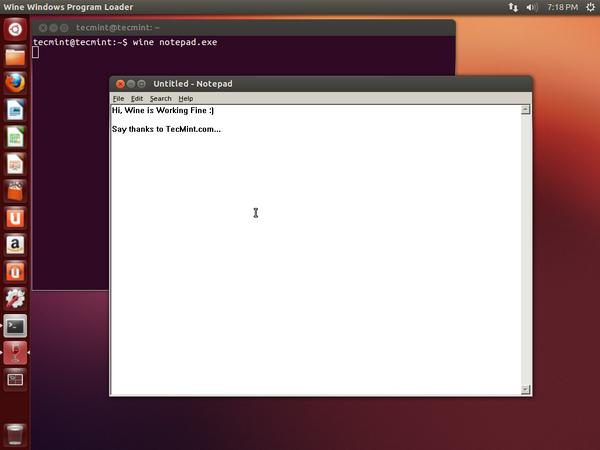
The default wine configuration is much enough for running windows applications, but not all windows based applications run under wine. And in some cases, you may require an extra configuration to run certain applications.
The wine configuration is done by ‘winecfg‘ utility, so in order to configure wine run the following command on the terminal.
$ winecfg
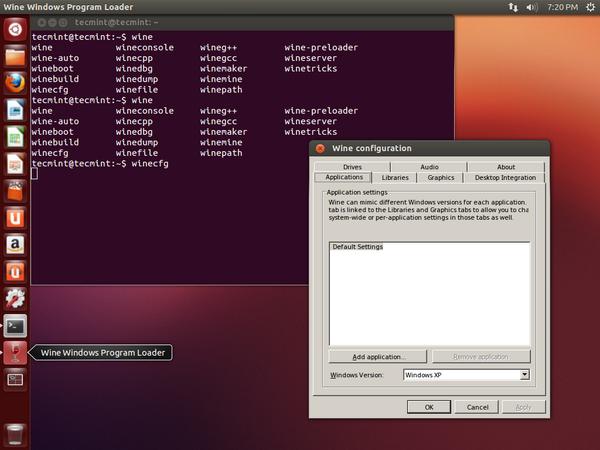
This is very useful for installing games and applications using cdrom/usb drives with wine under your system.
Install Windows Software’s Using Winetricks
Winetricks is a small helper script for downloading and installing windows based software and missing DDL files that needed to run some programs under wine.
To download and install software programs, run the ‘winetricks‘ utility from the terminal. Please note that the winetricks current prefix is user’s home directory (i.e. /home/user/.wine). So, whatever you install it goes under this directory.
$ winetricks
While running ‘winetricks‘ you might get the following error message:
/usr/bin/winetricks: 2201: /usr/bin/winetricks: cannot create /tmp/early_wine.err.txt: Permission denied ------------------------------------------------------ wine cmd.exe /c echo '%ProgramFiles%' returned empty string, error message 'wine: /home/tecmint/.wine is not owned by you'
To fix such permission error run the following command and replace the username with your own user.
# sudo chown -R username:username /tmp/early_wine.err.txt $ winetricks
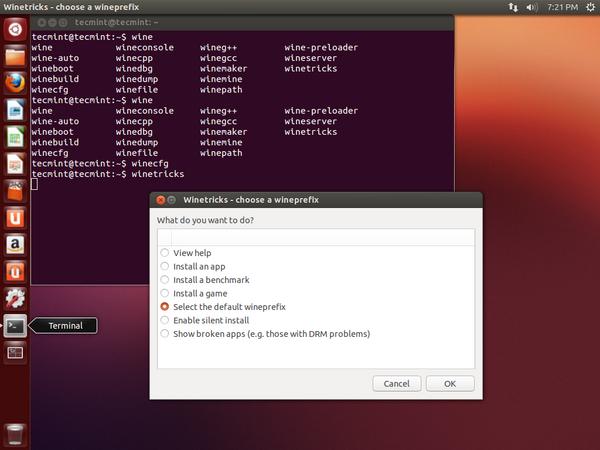
It will ask you one-time question about helping winetricks development by submitting reports on wine statistics. Just click on ‘Yes‘.
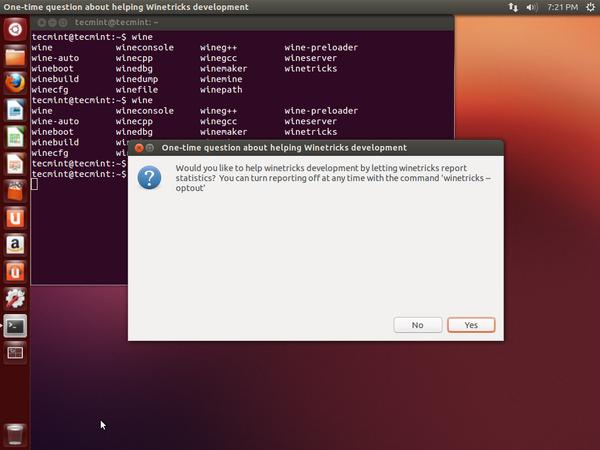
Click on ‘OK‘ button to move forward. If you don’t want to submit reports to winetricks, then simple turn-off with the command ‘winetricks –optout‘.
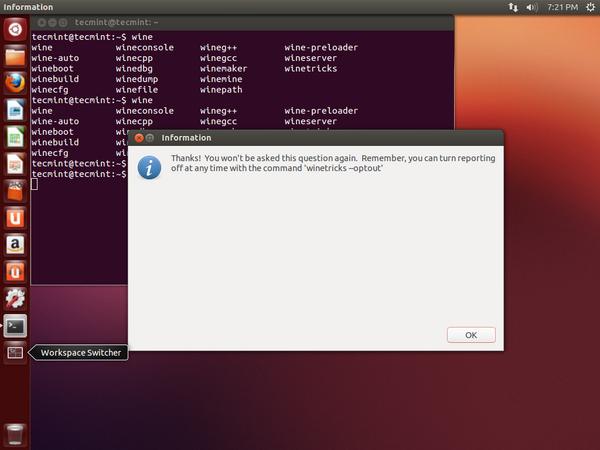
Next, select ‘Install a Windows DLL or component‘.
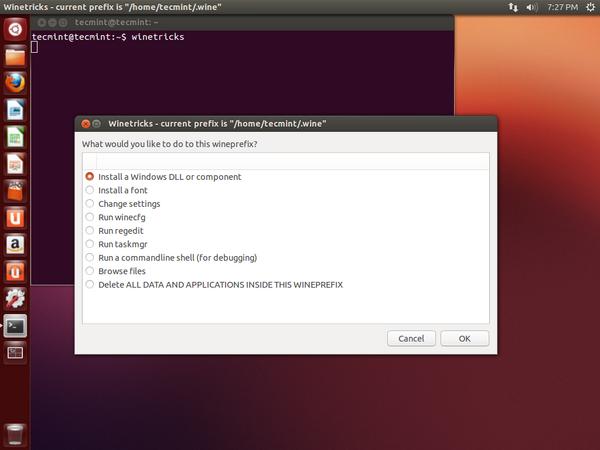
Select the software that you wish to install. Let’s say I would like to install Internet Explorer 8.
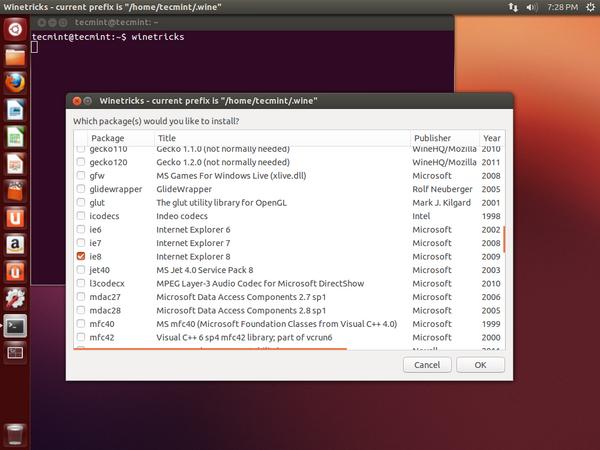
The utility automatically downloads and install the selected software from the winetricks table.
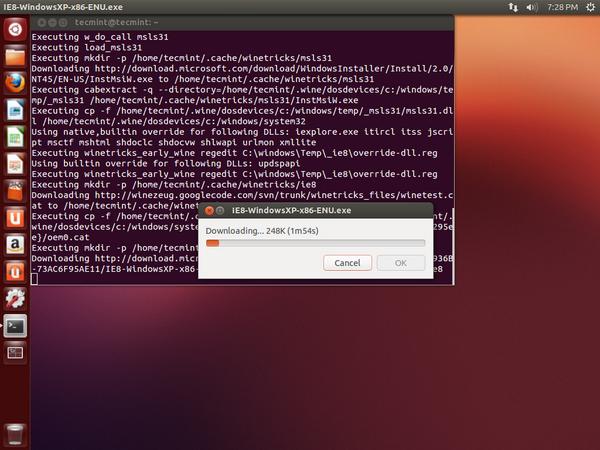
Once, the download and installation complete, it will automatically start the program. See the screenshot below.
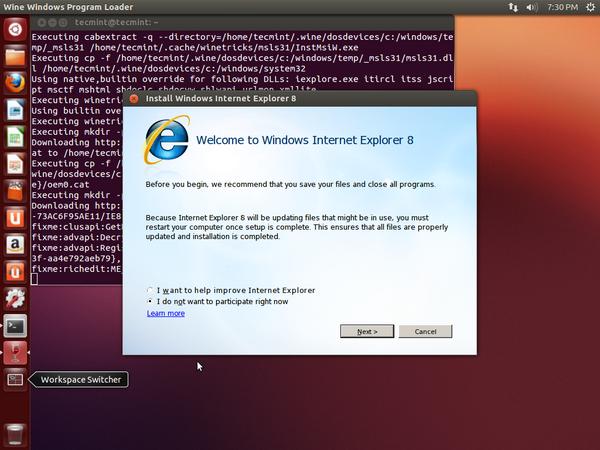
You can also start the program by specifying the full path of the program.
$ sudo wine 'C:\Program Files\Internet Explorer\iexplore'
As I said above that not all programs will work with wine. So, I recommend you to check out the Wine app database before installing any software through wine.
Uninstalling Windows Software using Winetricks
If you want to uninstall the Internet Explorer with winetricks just type the following command it will completely delete the program. You also directly delete the program directory from the .wine directory like shown below.
$ sudo rm -rf .wine/drive_c/Programe\ Files/Internet\ Explorer/
Uninstalling Wine and Winetricks
If you are not happy with the wine program, you can remove it completely by using the following command.
$ sudo apt purge winehq-stable
You can also download the Wine source package for other Linux distributions from the wine download page.
